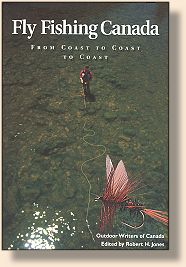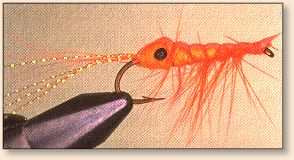While Prince Edward Island (PEI) offers limited
fishing for rainbows, steelhead and Atlantic salmon,
its native brook trout are widespread, both resident
and sea-runs. The island bubbles with cold springs,
and some amazing fishing can be found by merely
dropping a fly beside many roadside culverts. Larger
streams like the Morell and Dunk Rivers are also
productive.
"You've done a tremendous job here," I said to Dave
Biggar as we walked along Trout River in May. Digger
logs, deflectors and overhead cover structures were
in evidence in every section of the stream. In
addition to habitat rehabitation, Dave and his
volunteers must cope with a perennial Prince Edward
Island problem: bank erosion and runoff from
agricultural operations.
"You'd catch lots of small trout if you fished today," Dave
said, "but our reason really begins when the sea-runs
start arriving in a month or so."
Tom Corcoran had voiced these same sentiments when we
fished the Morell together, so off Dave and I went to
the estuary to search for bigger brookies in the salt.
Although "salter" is one of several colloquial names
gives to sea-run brook trout, I'll co-opt it for the
quarry in salt water. On Prince Edward Island, a
combination of flat countryside and rock-free soil
resulted in the formation of extensive, relatively
shallow inlet bays. These are often spanned at a
narrows by a combination of causeways and low bridges,
which create significant tidal currents. Salters
congregate in these flows and the nearby shallows.
As is true for virtually all inshore saltwater fishing,
knowledge of the tide is critical. On the Island, the
hot time at the bridges is the last three hours of the
ebb tide. Once the tide turns, the flow quickly becomes
heavily loaded with vegetative debris. Near high tide,
while the water is clear, it's too deep for effective
fly fishing.
At other tide times, it's more productive to fish in
the bays themselves. This is best done from a boat,
but there are a few places where cruising trout are
regularly found along the shorelines that are suitable
for wading. Such spots are best found by conversations
with local anglers or by watching the shoreline closely
while exploring an area.

Most residents fish for salters with bait, the favorites
being a sand shrimp and a local minnow known as "gudgeon"
(the proper name is mummichog). The few local fly fishers
try to match these species with shrimp imitations like
Lester the Lobster [see below] (taken from the
Squamish Poacher pattern originating on the West Coast)
or an orange Whiskers, and with a variety of small streamers.
Archie Clark, and experience island fly fishing, doubles
his odds by tying a streamer on the point and a shrimp
imitation on a dropper about 18" (46 cm) up the leader.
"While I catch most trout on the dropper," Archie told
me, "enough take the streamer to make me keep it on."
Just at dusk one evening, I saw dozens of sand shrimp
leaping across the surface of a shallow beach area.
The occasional splash and wake confirmed that they were
under attack by trout. A half-dozen casts before the
action stopped yielded nothing. Later, over after-dark
coffee, an experienced local angler told me that this
is a common occurrence, but that no fly fishers he know
of had ever solved the puzzle. Sand shrimp are about 2"
(5 cm) long, and a little research turned up the
interesting fact that they exhibit bioluminescence.
Armed with this knowledge, I hope to return to Prince
Edward Island with several new patterns, including a
few tied with phosphorescent materials. If the meantime,
if you happen to get there before me, bear this
information mind. It could make for some memorable
fishing.

Lester the Lobster (originator Joe Kambietz)
Tied by Bob Jones
Hook: Mustad 9672 No. 8 - 2.
Thread: Fluorescent red.
Eyes: Black 15-lb monofilament melted at ends;
tie in directly above hook point and wrap body material around
the eyes so they extend from head.
Beak: Fluorescent red thread or copper tinsel.
Feelers: Two to four strands of orange Krystal Flash
and orange bucktail.
Rib 1: 4-lb test clear monofilament (wound after all other
steps complete.)
Back: 1/8 - 1/4" (3-6 cm) wide orange surveyor's tape
or scud back (body size determines width), pulled over body
after hackle and rib.
Rib 2: Oval copper tinsel.
Body: Orange wool, tapered down toward eye.
Hackle: Orange, palmered over body.
Tag: Fluorescent red thread with a V-shaped tail
extending over hook eye. ~ PM
Credits: Excerpt from Fly Fishing
Canada written by Outdoor Writers of Canada,
edited by Robert H. Jones, Published by Johnson
Gorman Publishers. Used with permission.
| |



